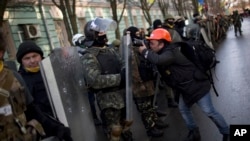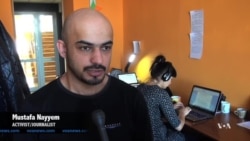When a Ukrainian women's plea for freedom went viral in February and received nearly eight million views, it demonstrated the power of social media in spreading the message of Ukraine's political reform.
Yulia Marushevska’s emotional YouTube plea spurred thousands of Ukrainians into the streets, but analysts say it is not the first time non-traditional media has helped shape Ukraine's social and political landscape.
Long before social media helped ignite the Arab Spring and other uprising in tense parts of the world, analysts say Ukraine's Orange Revolution in 2004 was the first revolt to organize and promote itself via the internet.
It began in 2000.
The internet was still new to Ukraine: about 200,000 of Ukraine's 49 million citizens were web users.
Among them was journalist Georghiy Gongadze, who launched Ukraine's first online newspaper, Ukrayinska Pravda, or "Ukrainian Truth," a venue to expose government corruption and abuses of power.
It was also a risky enterprise in a country where as many as five journalists had been killed for criticizing the government.
But the internet was so new that the government paid it little attention.
That would change quickly as word about Ukrayinska Pravda got out.
Watch related video from Daniel Schearf - story continues below:
Five months after the site launched, Gongadze disappeared. Weeks later his headless body was discovered in a forest more than 40 miles from home.
After a flawed investigation, the government suggested Gongadze had staged his own kidnapping or had an accident.
But an opposition leader shocked parliament and the nation by revealing secret audio recordings which suggested President Leonid Kuchma had ordered Gongadze's murder.
"At that time, the majority of the Ukrainian mass media were under the control of government oligarchs," said Volodymyr Lysenko, an information research scientist at the University of Washington.
Ukrayinska Pravda published transcripts of the so-called Melnychenko tapes, which boosted its readership from only a few hundred to more than one million.
Then Maidan launched, a website with the self-described purpose of "monitoring, defending, affirming and broadening constitutional rights and freedoms in Ukraine."
Social media in the Ukraine was off and running.
"Only through the internet were people able to access authoritative information, including those tapes about Gongadze," said Lysenko, an expert in the use of the internet for socio-political change.
"The internet now also allowed the Ukraine diaspora abroad — for example, here in the United States or in Canada — to watch what was going on live," he said.
Near the end of 2000, more than, 5,000 protesters marched in Kyiv, demanding an independent investigation into Gongadze's disappearance and the president's resignation.
There would be scattered protests for the next four years until the 2004, when rigged elections triggered the Orange Revolution.
The Orange Revolution
The 2004 polls pitted opposition favorite Viktor Yushchenko against Kuchma-backed Viktor Yanukovych.
Miroslaw J. Myj, the author of a 2005 study on the role of the internet in the Orange Revolution, told VOA that by the time of the election, the internet had become the only source of reliable political information in Ukraine.
It was also a powerful tool for election campaigning, he said.
"If you couldn't put out a legal ad in a newspaper, you would have turned to the internet," said Myj, a professor emeritus at Widener University's School of Business Administration.
"People realized you could attach political electioneering posters by email, you didn't have to deliver them," he said.
Still, by late 2004, only between two and four percent of Ukrainians were using the internet.
But most were university students or professors, journalists, researchers, young corporate workers or politicians — Ukraine's intellectual and political elite — and they constituted a powerful force for change.
On election day, social research groups conducted exit polls across Ukraine, which Ukrayinska Pravda published along with official government figures that varied significantly, and was concrete evidence that the vote had been tampered with.
Pro-democracy groups like Pora and Maidan leaped into action. Not only did they post information on the web, but via cellphone to thousands of registered cellphone users. After only 17 days of protests across the country, the government called for new elections, and Yushchenko came to power.
Tweeting a revolution
The latest wave of protests began last November, when Ukraine suspended planned agreements with the EU in favor of reviving ties with Russia. Several hundred Ukrainians gathered in Kiev's Independence Square to protest, and when police began to use violence against them, the crowds grew.
Joshua Tucker is Professor of Politics at NYU and one of four co-directors of the NYU Social Media and Political Participation Laboratory (SMaPP). His group began collecting data on social media usage in Ukraine from the first day of the protests.
"Initially we saw a much lower use of Twitter during the protests in Ukraine, for example, than we had seen in Turkey the previous spring, when there had been much, much more usage of Twitter — orders of magnitude higher," he said.
At first, SMaPP noticed that Facebook, not Twitter, was playing the bigger role in organizing the protests.
But as the protests went on, that began to change.
"Every time there's a big moment in the protests, we see a surge in new Twitter accounts created per day. And by the end of February, whereas before the crisis there were 50 new accounts created a day, by the end, we're looking at 600 to 800 accounts being created a day," Tucker said.
He says Ukrainians have become very savvy about using social media to reach international audiences.
"We see that one of the offers made by Yanukovych was rejected by one of the opposition leaders. He rejected it using Twitter and he did it in English," Tucker said. "And three hours later, it was in the New York Times—word for word."
Yulia Marushevska’s emotional YouTube plea spurred thousands of Ukrainians into the streets, but analysts say it is not the first time non-traditional media has helped shape Ukraine's social and political landscape.
Long before social media helped ignite the Arab Spring and other uprising in tense parts of the world, analysts say Ukraine's Orange Revolution in 2004 was the first revolt to organize and promote itself via the internet.
It began in 2000.
The internet was still new to Ukraine: about 200,000 of Ukraine's 49 million citizens were web users.
Among them was journalist Georghiy Gongadze, who launched Ukraine's first online newspaper, Ukrayinska Pravda, or "Ukrainian Truth," a venue to expose government corruption and abuses of power.
It was also a risky enterprise in a country where as many as five journalists had been killed for criticizing the government.
But the internet was so new that the government paid it little attention.
That would change quickly as word about Ukrayinska Pravda got out.
Watch related video from Daniel Schearf - story continues below:
Five months after the site launched, Gongadze disappeared. Weeks later his headless body was discovered in a forest more than 40 miles from home.
After a flawed investigation, the government suggested Gongadze had staged his own kidnapping or had an accident.
But an opposition leader shocked parliament and the nation by revealing secret audio recordings which suggested President Leonid Kuchma had ordered Gongadze's murder.
"At that time, the majority of the Ukrainian mass media were under the control of government oligarchs," said Volodymyr Lysenko, an information research scientist at the University of Washington.
Ukrayinska Pravda published transcripts of the so-called Melnychenko tapes, which boosted its readership from only a few hundred to more than one million.
Then Maidan launched, a website with the self-described purpose of "monitoring, defending, affirming and broadening constitutional rights and freedoms in Ukraine."
Social media in the Ukraine was off and running.
"Only through the internet were people able to access authoritative information, including those tapes about Gongadze," said Lysenko, an expert in the use of the internet for socio-political change.
"The internet now also allowed the Ukraine diaspora abroad — for example, here in the United States or in Canada — to watch what was going on live," he said.
Near the end of 2000, more than, 5,000 protesters marched in Kyiv, demanding an independent investigation into Gongadze's disappearance and the president's resignation.
There would be scattered protests for the next four years until the 2004, when rigged elections triggered the Orange Revolution.
The Orange Revolution
The 2004 polls pitted opposition favorite Viktor Yushchenko against Kuchma-backed Viktor Yanukovych.
Miroslaw J. Myj, the author of a 2005 study on the role of the internet in the Orange Revolution, told VOA that by the time of the election, the internet had become the only source of reliable political information in Ukraine.
It was also a powerful tool for election campaigning, he said.
"If you couldn't put out a legal ad in a newspaper, you would have turned to the internet," said Myj, a professor emeritus at Widener University's School of Business Administration.
"People realized you could attach political electioneering posters by email, you didn't have to deliver them," he said.
Still, by late 2004, only between two and four percent of Ukrainians were using the internet.
But most were university students or professors, journalists, researchers, young corporate workers or politicians — Ukraine's intellectual and political elite — and they constituted a powerful force for change.
On election day, social research groups conducted exit polls across Ukraine, which Ukrayinska Pravda published along with official government figures that varied significantly, and was concrete evidence that the vote had been tampered with.
Pro-democracy groups like Pora and Maidan leaped into action. Not only did they post information on the web, but via cellphone to thousands of registered cellphone users. After only 17 days of protests across the country, the government called for new elections, and Yushchenko came to power.
Tweeting a revolution
The latest wave of protests began last November, when Ukraine suspended planned agreements with the EU in favor of reviving ties with Russia. Several hundred Ukrainians gathered in Kiev's Independence Square to protest, and when police began to use violence against them, the crowds grew.
Joshua Tucker is Professor of Politics at NYU and one of four co-directors of the NYU Social Media and Political Participation Laboratory (SMaPP). His group began collecting data on social media usage in Ukraine from the first day of the protests.
"Initially we saw a much lower use of Twitter during the protests in Ukraine, for example, than we had seen in Turkey the previous spring, when there had been much, much more usage of Twitter — orders of magnitude higher," he said.
At first, SMaPP noticed that Facebook, not Twitter, was playing the bigger role in organizing the protests.
But as the protests went on, that began to change.
"Every time there's a big moment in the protests, we see a surge in new Twitter accounts created per day. And by the end of February, whereas before the crisis there were 50 new accounts created a day, by the end, we're looking at 600 to 800 accounts being created a day," Tucker said.
He says Ukrainians have become very savvy about using social media to reach international audiences.
"We see that one of the offers made by Yanukovych was rejected by one of the opposition leaders. He rejected it using Twitter and he did it in English," Tucker said. "And three hours later, it was in the New York Times—word for word."









